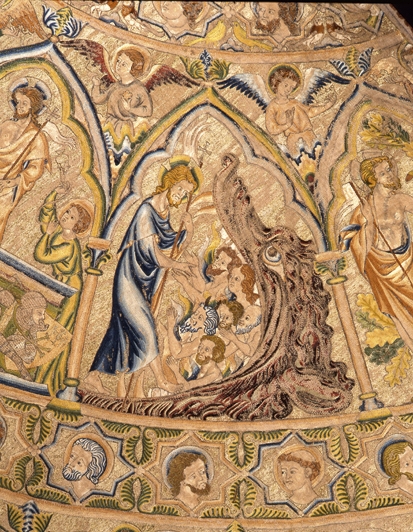Think of an art at which the English have excelled and I doubt you would come up with the word ‘embroidery’. As I muttered when my agent asked whether I should like to make a film for BBC4 about the golden age of this forgotten but brilliant native art form: ‘Embroidery? What, like sewing?’ But no, not like sewing. Or, actually, only a little bit.
During the ‘high’ Middle Ages, English embroidery was one of the most desired and costly art forms in Europe. It was known as opus anglicanum or ‘the work of the English’ — a generic name that instantly conjured notions of craftsmanship, beauty, luxury and expense in the minds of those who heard it.
English embroidery was an art that combined extraordinary design, painstaking manual dexterity and some of the most costly raw materials (gold, silks and precious jewels) on earth. To lay hands on a really splendid piece would set you back as much as it would to commission Giotto. Opus anglicanum was celebrated and coveted all over Christendom.
Today it is largely forgotten, which is odd since the most famous piece of English medieval art is, of course, an embroidery. It’s called the Bayeux Tapestry: a misnomer, because, while tapestry is woven on a loom, embroidery is stitched by hand with a needle and thread.
To see the 230ft Bayeux Embroidery (feel free to earn pedant points by calling it this from now on) you have to go to Normandy, but it was probably made in Kent, where it took about seven years to produce and cost its commissioner, William the Conqueror’s half-brother Bishop Odo of Bayeux, a small fortune. Ironically, given that the Bayeux Embroidery celebrates the conquest and subjection of the English people, the work itself marks the beginning of an age in which they would become artistic geniuses.
The English could and did embroider pretty much anything: military outerwear, bedclothes, pillows, bags, purses, wall hangings; all were stitched with intricate images and decorated with precious stones. What survives today, however, consists mainly of religious vestments. The vast wealth of the high medieval Church and the desire of the greatest churchmen to show off meant that they could afford the most ambitious commissions.
An early example is hidden down in the vaults of Canterbury cathedral: a pair of rather natty slippers removed from the tomb of Archbishop Hubert Walter (d.1205). The colours are faded, but they are intricately embroidered in silk thread, decorated with stars, fleurs-de-lis, lions and dragons, and studded with garnets.
And these were only slippers. During the 13th century, money poured into English embroidery and the quality of the work became better and better. Draftsmen adapted the latest techniques in gothic figurative art to decorate vestments, altar frontals and the like with, for the time, stunningly lifelike scenes from the Bible and the lives of the saints. The women who wielded the needles — yes, the best technicians in one of our greatest historical art forms were overwhelmingly female — pioneered brilliant new techniques. Split stitching allowed them to give their artwork unparalleled texture and depth. Underside couching meant that ceremonial clothes could be decorated with thick gold thread without becoming too stiff and unwieldy to wear.
From the mid-13th to the mid-14th centuries the English were producing genuine wonders: magnificent copes vividly decorated with biblical scenes and stories, or with the grisly martyrdoms of saints. One of the biggest markets was Rome, where successive popes amassed a vast collection of opus anglicanum, combining the three chief Italian passions for fashion, piety and ostentatious displays of wealth. Money poured into England and embroidery sailed out. The party was ended only with the Black Death, which killed off a generation of skilled embroiderers and gutted the industry. By the 15th century, the centre of production had moved to the Low Countries and the quality had declined, never again to reach its high gothic splendour.
Sadly, hardly any medieval English embroidery survives: it was inherently fragile in any case, and richly decorated, ‘popish’ religious vestments were anathema to the hotter Protestants of the Reformation and, later, the Commonwealth. Much of the stuff was destroyed in the iconoclastic purges of the 16th and 17th centuries: burned to pilfer the gold thread and jewels. Perhaps 35 really serious examples survive — many of them in Italian museums with a couple of extraordinary pieces in London’s V&A. But this is more than enough for us to taste what was not just a luxurious and dazzling medieval indulgence, but also one of English history’s most underappreciated art forms.
Dan Jones presents Fabric of Britain: The Wonder of Embroidery on 2 October at
9 p.m. on BBC4.








Comments